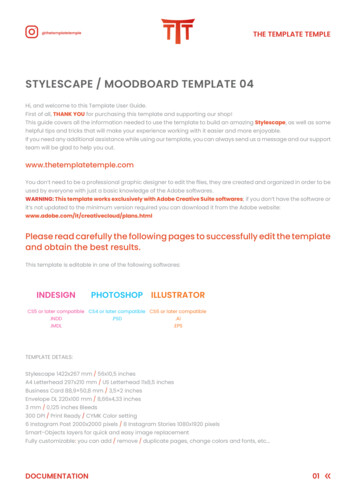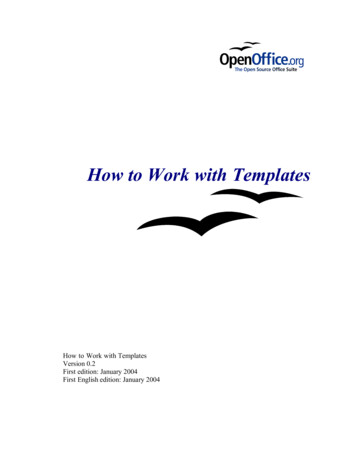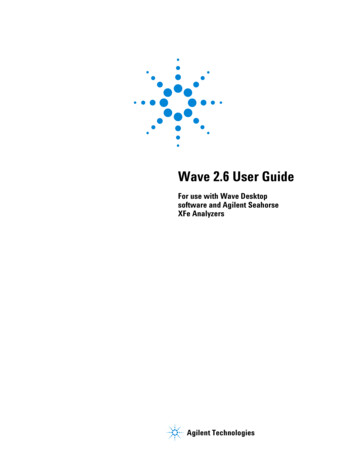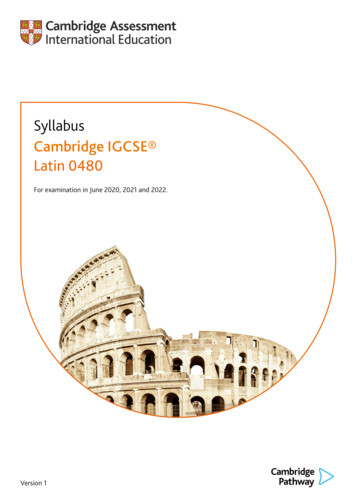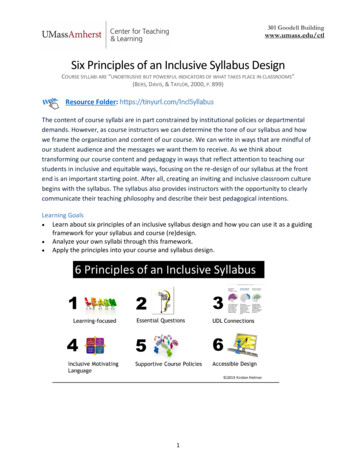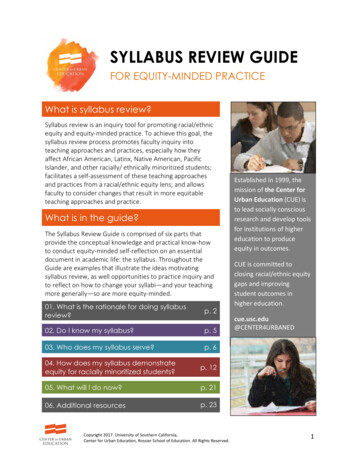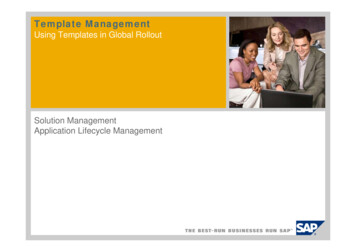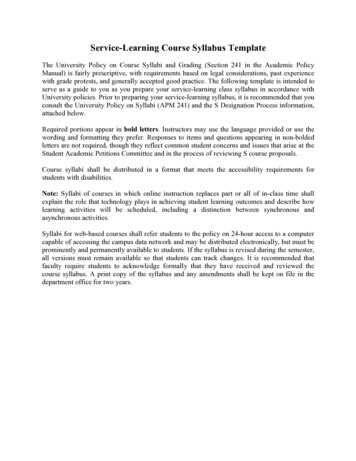
Transcription
Service-Learning Course Syllabus TemplateThe University Policy on Course Syllabi and Grading (Section 241 in the Academic PolicyManual) is fairly prescriptive, with requirements based on legal considerations, past experiencewith grade protests, and generally accepted good practice. The following template is intended toserve as a guide to you as you prepare your service-learning class syllabus in accordance withUniversity policies. Prior to preparing your service-learning syllabus, it is recommended that youconsult the University Policy on Syllabi (APM 241) and the S Designation Process information,attached below.Required portions appear in bold letters. Instructors may use the language provided or use thewording and formatting they prefer. Responses to items and questions appearing in non-boldedletters are not required, though they reflect common student concerns and issues that arise at theStudent Academic Petitions Committee and in the process of reviewing S course proposals.Course syllabi shall be distributed in a format that meets the accessibility requirements forstudents with disabilities.Note: Syllabi of courses in which online instruction replaces part or all of in-class time shallexplain the role that technology plays in achieving student learning outcomes and describe howlearning activities will be scheduled, including a distinction between synchronous andasynchronous activities.Syllabi for web-based courses shall refer students to the policy on 24-hour access to a computercapable of accessing the campus data network and may be distributed electronically, but must beprominently and permanently available to students. If the syllabus is revised during the semester,all versions must remain available so that students can track changes. It is recommended thatfaculty require students to acknowledge formally that they have received and reviewed thecourse syllabus. A print copy of the syllabus and any amendments shall be kept on file in thedepartment office for two years.
Introduction and Course DescriptionInclude course name, course number, number of units, time, and location. Offer a briefcourse description and explain how the course fits into the curriculum (General Education,Major, Certificate, prerequisite for other courses, etc.). Why should a student take the course?This is also a good place to explain why you have organized the course the way you have. Youmay wish to consult the course description in the University Catalog as you prepare this section,to ensure your description is aligned with the University's.Faculty may also wish to include statements on instructional philosophy and pedagogicalmethods, non-enrolled visitors or guests, General Education requirements met by the course, andother information of importance and concern to the instructor. Reference can also be made toUniversity policies judged to be a particular importance to the conduct of the class (e.g.,disruptive behavior). Faculty should be certain that any such statements are consistent withUniversity policy.Syllabus for Course Name (Course Number, such as CFS 133S)California State University, FresnoSpring 2010Course Information:Instructor NameUnitsOffice NumberTimeE-MailLocationTelephoneWebsiteOffice HoursOther contact information such as websiteCatalog Description: Example from CFS 133S-- This course ? stress and crisis as experiencedand perceived by children and their families. Topics to be discussed including child abuse,divorce, remarriage, death, substance abuse, disability, immigration, poverty, and diversepopulations.Enhanced Description: Provides a more comprehensive understanding of what the course willentail. In describing the course, an explanation of how the service-learning supports theacademic focus should be included in the syllabus. As part of the justification required for SDesignation proposals, faculty are asked to describe how the service-learning assignment will beintroduced to the students including references in the syllabus to any source(s) and proceduresthat will be followed to reinforce the service ethic. This information may be included in thegeneral description, the service-learning assignment description and/or the course schedule.Example from Communication 114: In this class, we will examine the nature of communication;its relationship to learning and instruction; and the importance of utilizing effectivecommunication strategies in the educational setting. A knowledge and use paradigm is used toguide the curriculum in this course. Each student will develop new knowledge about the role ofcommunication in the classroom and be given the opportunity to put this knowledge to use.Students will participate in a number of activities both inside and outside the classroom.Students will be exposed to various teaching techniques through a variety of modalities and will
have an opportunity to observe and practice the information learned through participation inservice-learning. Students will learn by reading, writing, observing, listening, doing, discussing,analyzing, synthesizing, reflecting, and evaluating.Course Goals and Primary Learning OutcomesCourse Goals: What do you, as the instructor, intend to accomplish through instruction?Example from CFS 133S -- This class will provide you the opportunity to examine children andfamilies in crisis. Unlike the typical university course, the content of this class, in somesituations, may elicit strong emotional responses. The outcome of our exploration will be adeeper understanding of the impact of crisis on the human experience and the enhanced abilityto assist yourself and others in coping with crisis.Primary Learning Outcomes: What should students have learned or what should they be ableto do when they complete the course? Primary learning outcomes stem from course goals andshould be targeted statements about expected student performance. In general, they arecompetency-based and measurable, in that they describe exactly what the student must do todemonstrate mastery of course material. Use specific language (e.g., analyze, compare, describe,list, formulate, derive) rather than terms such as "know" and "understand" which may havedifferent meanings for students and instructors. For additional information, please refer to thedepartmental Student Outcomes Assessment Plans. For service-learning courses, one or more ofthe learning outcomes should be specifically related to the service-learning component of thecourse.Example from SOC 130WS (modified) –This course has been designed to provide you, the student, with the opportunity to:1. develop a unique way of interpreting human behavior (i.e., a sociological perspective) tobetter understand and examine the world we live in;SLO: Students will be able to make connections between personal, private, troubles andlarger, social issues and describe these connections in writing and through oralcommunication.2. develop/expand your skills of thinking critically, writing, listening, reading, evaluating,speaking, doing library research, and relating to others;SLO: Students will indicate their responses to various social issues through small group andpartner communication exercises, report on and critique the assigned readings throughjournaling, evaluate peers' papers, and assemble research for a written paper that they willorally present to the class.3. examine several currently debated social issues (including, but not limited to, globalization,social inequality, corporate power, campaign financing, welfare, health care, urban racialtensions, crime) from a sociological perspective (i.e., to develop the ability to place socialproblems in a broader social context);SLO: Students will summarize in writing the main points from the lectures and readings onat least three social issues and evaluate the arguments and evidence presented.
4. develop job skills, make professional contacts, and deepen your understanding of the “booklearned” material through community service;SLO: Students will list at least two benefits of participating in service to the community andinterpret the book-learned material through written application of specific concepts andtheories to their service.5.become aware of a particular agency’s mission statement and acquaint yourself with the needsthat the organization is meeting as a whole (i.e., understand how nonprofit community-basedorganizations are making a difference in our society and contributing to a more civilsociety);SLO: Students will evaluate a particular agency in writing by examining its missionstatement and how well it is meeting fulfilling its mission.6.develop a civic ethic and come to understand the importance of participating in: a) service toyour local community and b) the political process;SLO: Students will summarize in writing their feelings about the importance of civicparticipation.PrerequisitesWhat are the prerequisites and how will you build on them? You may wish to refer students toresources for correcting weaknesses that might interfere with their learning in the course.Example from Sociology 130WS – G.E. Foundation (including “C” or better in the English Composition requirement) Junior-level class standing (60 units completed as of the end of this semester)What You Will Need to Purchase for this CourseTextbook, handouts, additional materials, course fees (if any), etc. Will you require the use ofemail? Internet accounts are available for fee at http://www.cvip.net .Study Expectations. Consider using the following statement:It is usually expected that students will spend approximately 2 hours of study time outside ofclass for every one hour in class. Since this is a-unit class, you should expect to study anaverage ofhours outside of class each week. Some students may need more outside studytime and some less.For free tutoring on campus, contact the Learning Center in the Collection Level (basementlevel) of the Henry Madden Library. You can reach them by phone at 278-3052 or visitwww.csufresno.edu/learningcenter ).
Examinations and Major AssignmentsWhat will the examinations be like? When are they scheduled? How will they be structured?How will students know which material to emphasize? How much material on exams will betaken from reading assignments? Will exams be comprehensive?Is attendance mandatory? Remind students "If you are absent from class, it is yourresponsibility to check on announcements made while you were away." If you intend to gradeon participation or tardiness, be explicit in explaining how you will do so. Specific to thiscourse, the instructor should mention the requirements related to participating in and regularlyattending their service site/activities. Disagreement over class participation and the lack of cleargrading standards and grading scale have been the bases for several grade protests.Example from Marketing 100S – Consider attendance of lectures as the equivalent of a businessappointment with your immediate supervisor, or with a person at the next higher level. Workschedules, other courses, job interviews, and student activities are not acceptable excuses formissing class. Those are commitments you must learn to manage without failing to meet thecommitment to this course. Attendance is required and will be taken. Attendance may be taken atany time during the scheduled lecture hours. A student is allowed to miss maximum of 2 classeswithout penalty. When missing any class in excess of 2 absences for which the student does nothave a written statement from a doctor the student will receive a letter grade reduction in thecourse. You are expected to be on time and three late arrivals or early departures will berecorded as on absence.If you are unable to attend scheduled service hours, you should contact the service sitecoordinator at least 24 hours in advance or as soon as possible prior to the planned service.Please remember that these agencies and the individuals served are depending on your regularattendance. Missing scheduled service hours will not only have an impact on your course grade,but can also negatively impact individuals who were depending on your assistance.Do you have a make-up policy and how does it work? Explain how you will handle absences,missed exams, missed labs, late homework and/or paper submissions. Provide thoughts on howstudents should handle necessary absences due to illness or emergency, including contacting theinstructor related to missing class and for contacting service site supervisor.What will the major assignments (e.g. papers, field trips, projects, etc.) be like? How willcompleting the assignments help students achieve the course learning goals? When areassignments due?Service-learning courses must require a minimum of 15 hours (20 hours is optimal) ofacademically relevant community service. These hours and other requirements that document theservice-learning experience (papers, presentations, etc.) should contribute to at least 20% of thestudent's course grade. The course syllabus should provide a description of: (a) the type ofagency where the service-learning assignment will be completed and/or typical serviceactivities which will meet the service requirement; (c) the length of time students will be
required to serve; (d) how verification of service hours will be completed; and (e) how thisrequirement will be included in the course grade.Example of service-learning assignment description from COMM 114 (adapted) - Service-Learning Hours - 20% of course grade (Outcomes 11-14)Each student will complete a minimum of 20 hours of service-learning. (Some sites may requireadditional time for orientation.) The purpose of this assignment is to enhance studentunderstanding of course material, integrate the concepts explored in this course, facilitate abetter understanding of the educational communities in which teachers work, and providestudents with an opportunity to practice teaching. Students are expected to attend as assigned, bepunctual, show initiative and enthusiasm, and call the supervisor if for any reason they cannotattend at a scheduled time. A verification of service hours must be signed by the service sitesupervisor and submitted to the instructor by the due date in order for this requirement to bemet. STUDENTS MAY NOT BEGIN THEIR SERVICE HOURS UNTIL THE “SERVICELEARNING LEARNING PLAN” IS COMPLETED, SUBMITTED AND APPROVED BY THECOURSE INSTRUCTOR!Faculty should include a mechanism, such as a paper or presentation, that relates the experientiallearning of community service to specific course content. Faculty are asked to describe in thecourse syllabus how the student will integrate the service-learning experience with coursecurriculum via such a mechanism.Additionally, faculty are asked to explain in the syllabus how critical analysis or reflectionon their service experience will be integrated into the course. This may be accomplished inmultiple ways including, but not limited to the required mechanism for connecting the coursecontent to the community experience mentioned above. Please note that structured opportunitiesfor critical reflection on the service experience should be included throughout the course. Reflection/Observation Paper - 5% of course grade (Outcomes 11,12,14)Students will write a 4 page, 12-point, double-spaced paper reflecting on their service-learningexperience. In the paper students should: 1) Identify the educational program in which theycompleted their service and describe the children this program serves. 2) Describe the classroomculture and physical layout and explain how these characteristics impacted student-teachercommunication and student-student interaction. 3) Based on observation, describe and evaluatethe immediate supervisor’s use of immediacy, self-discloser, humor, and classroom managementskills and substantiate observations with specific examples. 4) Describe their service-learningexperience. Describe in detail at least one child with whom they worked. Identify the strategiesthey used to insure learning. Explain how they addressed behavior issues. Evaluate whether ornot these strategies were successful. 5) Describe how their knowledge of diversity issuesinfluenced their approach to working with this child. 6) Relate the single most important lessonthey learned from their service experience. (See Attachment A) Site supervisor's feedback - 5% of course grade (Outcomes 12,13)The site supervisor will complete an evaluation of the student’s service-learning. The evaluationwill be completed toward the end of the semester. (See Attachment B)
Thank you - 5% of course grade (Outcomes 11,12, 14)This assignment provides the student with an opportunity to thank their service-learningsupervisor for their guidance and support. It is also an opportunity to thank the supervisor forproviding this service to the children they serve. The letter should thank the supervisor for theopportunity to work in their program and should highlight the specific work the studentcompleted. The student should personalize the letter with anecdotes and observations about thechildren they worked with and note aspects of the program they found particularly interesting.Students should mention how they have grown as a result of their participation in the programand describe what they have learned through this experience. The letter should be typed andinclude the full name and address of the immediate supervisor. A stamped envelope addressed tothe supervisor should accompany the letter. Spelling and grammar should be flawless. Studentswill make one copy of the letter, sign both letters, and turn both letters with the envelope to theinstructor. Students should not seal the envelope. (See Attachment C) Service-Learning Surveys - 5% of course grade (Outcomes 11, 12)Students will be required to complete service-learning surveys for your instructor and for the Janand Bud Richter Center for Community Engagement and Service-Learning.GradingExactly how will you calculate the grades? What will be the point values and weights forassignments, activities, and examinations? The cut-off points for each grade? An "Assignmentand Examination Schedule" with point values, may be an efficient way to transmit some of thisinformation:Example from Sociology 130WS –Percentage oftotal nmentResearch Paper (Draft Final)Service-Learning Paper/Field Notes/Agency Evaluation“Reflection Précis”English Exercises (1.0, 1.5, 2.0, 2.5, 3.0, 3.5)Oral PresentationReading JournalFINAL (in-class essay)ParticipationWrap-up/Celebration PaperLetter to the Editor/Representative1-Page Sample Précis“Free Writing” Journal“Mini Meeting”Points possible160 points125 points75 points75 points60 points50 points35 points35 points25 points25 points15 points10 points10 pointsThere are 700 total points possible in this course. Grades follow the standard university scale: 90% andabove is an A; 80-89% is a B, etc. Grades will NOT be curved.A 700 – 630pointsB 629 – 560pointsC 559 – 490pointsD 489 – 420pointsF 0 – 419points
Assignment and Examination ScheduleThis can be presented in any number of ways, but is typically done in a table format that includesinformation such as the due date, assignment, points available and any other relevantinformation. This information can also be integrated into a more comprehensive courseschedule, which typically appears as the last item in a course syllabus.Be sure to include in the syllabus a statement such as:This syllabus and schedule are subject to change in the event of extenuating circumstances. Ifyou are absent from class, it is your responsibility to check on announcements made while youwere absent.Note: If you are teaching an electronic course and plan to give your exam online, or not meetthe class on the final exam day in your classroom, you need to inform students in your syllabus.You also need to address a memo to that effect to your department chair and dean.Course Policies & Safety IssuesClearly state your concerns or prohibitions, if any (talking in class, cell phones, chewinggum, tobacco, wearing baseball caps, reading newspapers in class or other distracting behavior,tape-recording the lecture, bringing visitors or guests, etc.). Are students always expected towork independently, or is collaboration sometimes encouraged? Clearly state when students mayand/or may not work together. Also, address safety issues, if relevant (labs, shops, servicelearning sites, etc.).You may want to include a statement describing appropriate behavior in your classroom,especially if your course includes student discussion of sensitive issues. The University Policy onDisruptive Classroom Behavior (APM 419) is well worth reading and can be found in the ClassSchedule and the Academic Policy Manual. In addition to defining disruptive behavior anddetailing formal procedures for dealing with it, the policy contains a useful description of thelearning environment (see excerpt below). If you wish to use the Turnitin.com plagiarismdetection service, your syllabus must give students the opportunity to opt out of the service, asTurnitin.com maintains submitted materials in its database and copyright issues have arisenPlagiarism Detection. The campus subscribes to the Turnitin.com plagiarism preventionservice, and you will need to submit written assignments to Turnitin.com. Your work will beused by Turnitin.com for plagiarism detection and for no other purpose. The student mayindicate in writing to the instructor that he/she refuses to participate in the Turnitin.com process,in which case the instructor can use other electronic means to verify the originality of their work.Turnitin.com Originality Reports WILL/WILL NOT* be available for your viewing.*FACULTY: Please choose for your course WILL or WILL NOT be available for your viewing.University PoliciesThe syllabus must note the university Policy on Students with Disabilities, the UniversityHonor Code, the Policy on Cheating and Plagiarism, a statement on copyright, and theuniversity computer requirement. University policies can be included in the syllabus by
reference to statements in the University Catalog and Class Schedule. For example, one mightstate: "For information on the University's policy regarding cheating and plagiarism, refer to theClass Schedule (Legal Notices on Cheating and Plagiarism) or the University Catalog (Policiesand Regulations)." These may also be incorporated by directing students to the online requiredsyllabus policy statement page:http://www.csufresno.edu/academics/policies .htmBelow are some sample statements that provide more than just the reference. In all instances, it isrecommended that specific examples of what you consider to be cheating and plagiarism beincluded. See also those listed in the University Policy.Students with Disabilities: Upon identifying themselves to the instructor and the university,students with disabilities will receive reasonable accommodation for learning and evaluation. Formore information, contact Services to Students with Disabilities in the Henry Madden Library,Room 1202 (278-2811).Honor Code: “Members of the CSU Fresno academic community adhere to principles ofacademic integrity and mutual respect while engaged in university work and related activities.”You should:a) understand or seek clarification about expectations for academic integrity in this course(including no cheating, plagiarism and inappropriate collaboration)b) neither give nor receive unauthorized aid on examinations or other course work that isused by the instructor as the basis of grading.c) take responsibility to monitor academic dishonesty in any form and to report it to theinstructor or other appropriate official for action.Instructors may require students to sign a statement at the end of all exams and assignments that“I have done my own work and have neither given nor received unauthorized assistance on thiswork.” If you are going to use this statement, include it here.Cheating and Plagiarism: "Cheating is the actual or attempted practice of fraudulent ordeceptive acts for the purpose of improving one's grade or obtaining course credit; such acts alsoinclude assisting another student to do so. Typically, such acts occur in relation to examinations.However, it is the intent of this definition that the term 'cheating' not be limited to examinationsituations only, but that it include any and all actions by a student that are intended to gain anunearned academic advantage by fraudulent or deceptive means. Plagiarism is a specific form ofcheating which consists of the misuse of the published and/or unpublished works of others bymisrepresenting the material (i.e., their intellectual property) so used as one's own work."Penalties for cheating and plagiarism range from a 0 or F on a particular assignment, through anF for the course, to expulsion from the university. For more information on the University'spolicy regarding cheating and plagiarism, refer to the Class Schedule (Legal Notices on Cheatingand Plagiarism) or the University Catalog (Policies and Regulations).Computers: "At California State University, Fresno, computers and communications links toremote resources are recognized as being integral to the education and research experience.
Every student is required to have his/her own computer or have other personal access to aworkstation (including a modem and a printer) with all the recommended software. Theminimum and recommended standards for the workstations and software, which may vary byacademic major, are updated periodically and are available from Information TechnologyServices (http://www.csufresno.edu/ITS/) or the University Bookstore. In the curriculum andclass assignments, students are presumed to have 24-hour access to a computer workstation andthe necessary communication links to the University's information resources."Disruptive Classroom Behavior: "The classroom is a special environment in which studentsand faculty come together to promote learning and growth. It is essential to this learningenvironment that respect for the rights of others seeking to learn, respect for the professionalismof the instructor, and the general goals of academic freedom are maintained. . Differences ofviewpoint or concerns should be expressed in terms which are supportive of the learning process,creating an environment in which students and faculty may learn to reason with clarity andcompassion, to share of themselves without losing their identities, and to develop anunderstanding of the community in which they live . . . Student conduct which disrupts thelearning process shall not be tolerated and may lead to disciplinary action and/or removal fromclass."Copyright policy: Copyright laws and fair use policies protect the rights of those who haveproduced the material. The copy in this course has been provided for private study, scholarship,or research. Other uses may require permission from the copyright holder. The user of this workis responsible for adhering to copyright law of the U.S. (Title 17, U.S. Code). To help youfamiliarize yourself with copyright and fair use policies, the University encourages you to visitits copyright web es/docs/copyrtpolicyfull.pdfDigital Campus course web sites contain material protected by copyrights held by the instructor,other individuals or institutions. Such material is used for educational purposes in accord withcopyright law and/or with permission given by the owners of the original material. You maydownload one copy of the materials on any single computer for non-commercial, personal, oreducational purposes only, provided that you (1) do not modify it, (2) use it only for the durationof this course, and (3) include both this notice and any copyright notice originally included withthe material. Beyond this use, no material from the course web site may be copied, reproduced,re-published, uploaded, posted, transmitted, or distributed in any way without the permission ofthe original copyright holder. The instructor assumes no responsibility for individuals whoimproperly use copyrighted material placed on the web site.Tentative Course ScheduleThe syllabus must include a tentative schedule of topics covered, a schedule of assignedreadings, exam dates (including the date and time of the final exam) and assignment due dates.You may wish to include a statement similar to the following: “The schedule and procedures forthis course are subject to change in the event of extenuating circumstances.”The following is a tentative course schedule for Sociology 130WS.
TOPICS AND READINGS SYLLABUS*Wks. 1 & 21/16, 23, 28Intro to Sociology, each other, & this courseGenerating Ideas for Writing/Thesis Statements Preface & Ch. 1 in The Wilding of America (Derber)Week 31/30 & 2/4Fallacies and PropagandaEx. #1.0 & 1.5 (25 pts)America—A Wilding Culture?Sign-up for topics Issue 1: Is America in Moral Decline? Taking Sideso Ch. 2 in The Wilding of America (Derber)Week 42/6 & 2/11Persuasive Writing/Parts of SpeechWilding Culture in the Media & Everyday Life Ch. 3 in The Wilding of America (Derber)Week 52/13 & 2/20 Ex. #2.0 & 2.5 (25 pts)Basic Rules of WritingEx. #3.0 & 3.5 (25 pts)Corporate PowerService-Learning Learning Plan dueIssue 11: Is Government Dominated by Big Business?Taking SidesBernstein, Aaron. 2000. “Too Much CorporatePower?” Business Week, September 11,pp. 144-150, 152-154, 158. Available at:http://www.businessweek.com/2000/00 37/b3698001.htmLasn, Kalle Lasn & Tom Liacas. 2000. “The Birth” & “The Rule.”Adbusters, Aug/Sept. Available at:http://www.wilpf.org/CPOWER 10sessions, Session 3, Part %5D%5B1%5D.doc.pdf“Northern CA City Challenges Corporate Personhood: A New Strategyfor Placing Limits on Corporate Power.” 2000. A
Service-Learning Course Syllabus Template The University Policy on Course Syllabi and Grading (Section 241 in the Academic Policy Manual) is fairly prescriptive, with requirements based on legal considerations, past experience with grade protests, and generally accepted good practice. The following template is intended to




